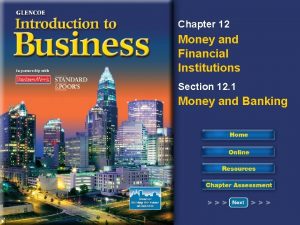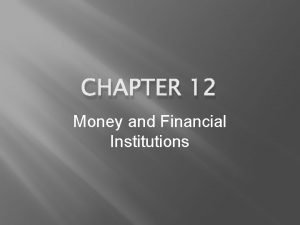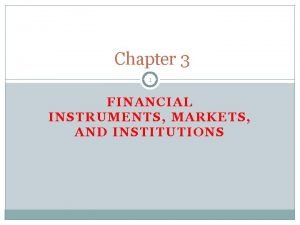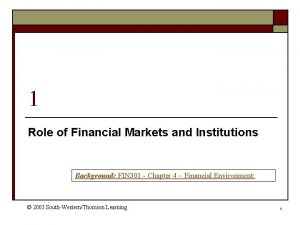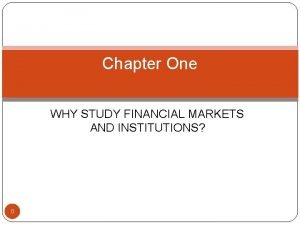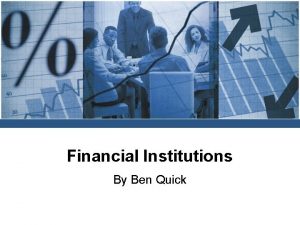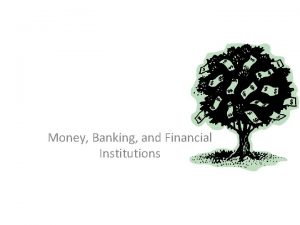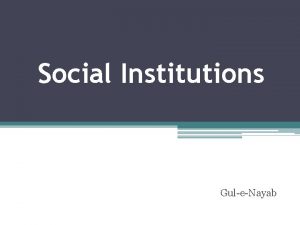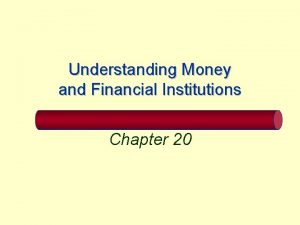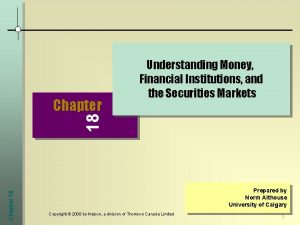CHAPTER 12 Money and Financial Institutions History of











- Slides: 11

CHAPTER 12 Money and Financial Institutions

History of Money In the monetary system goods and services are indirectly exchanged using money, which can then be exchanged for other goods and services. Money can be anything that people accept as standard for payment.

1. 2. 3. Functions of Money Medium of exchange – money changes hands. 2. Standard of value –means for measuring the value of goods and services. Store of value – holds its value over time and can be stored or saved.

Characteristics of Money Scarce 2. Accepted 3. Divisible 4. Portable and durable 1.

Banking The banking system is the main type of financial institution, or organization for managing money, in our economy. 3 main functions of a bank: 1. Storing Money 2. Transferring Money 3. Lending Money

Storing Money A bank account is a record of how much money a customer has put in to or taken out of a bank. The money put in a bank is called a deposit, and the money taken out is called a withdrawal. Interest = money banks pay to depositors for use of their funds, or cost of the loan There are two main types of accounts: � Checking accounts

Transferring Money Every single business transaction involves the transfer of money. Today more banks are using electronic funds transfer (EFT) to move money around. With EFT, money is transferred from one account to another through a network of computers.

Lending Money The money you deposit in a bank makes it possible for the bank to lend money to other customers. Collateral is something valuable you put up for a loan, such as a car or a coin collection, so that the bank can take it if you fail to pay back the loan. There are 4 main types of loans banks offer to businesses and individuals: 1. Mortgage loan (house would be your collateral) 2. Commercial loan 3. Individual loan 4. Line of credit

Other Financial Services � Safety-deposit boxes - store valuable items, such as jewelry and certificates � Offer credit cards such as Master. Card or Visa. � Manage trust funds

Types of Banks 1. Commercial Banks 2. Savings and Loan Associations 3. Credit Unions

The Federal Reserve System (or Fed) is the central banking organization in the US Functions of the Fed 1. Clearing checks 2. Acting as federal government’s fiscal agent 3. Supervising member banks 4. Regulating the money supply 5. Setting reserve requirements 6. Supplying paper currency
 Chapter 12 money and financial institutions
Chapter 12 money and financial institutions Chapter 12 money and financial institutions
Chapter 12 money and financial institutions Money money money team
Money money money team Why study financial market
Why study financial market Financial markets and institutions jeff madura ppt
Financial markets and institutions jeff madura ppt Financial institutions and markets lecture notes ppt
Financial institutions and markets lecture notes ppt Basic flow of funds through the financial system
Basic flow of funds through the financial system Madura j. financial markets and institutions
Madura j. financial markets and institutions Primary vs secondary financial markets
Primary vs secondary financial markets Madura j financial markets and institutions
Madura j financial markets and institutions Why study financial markets and institutions
Why study financial markets and institutions Chapter 16 money management and financial planning
Chapter 16 money management and financial planning
